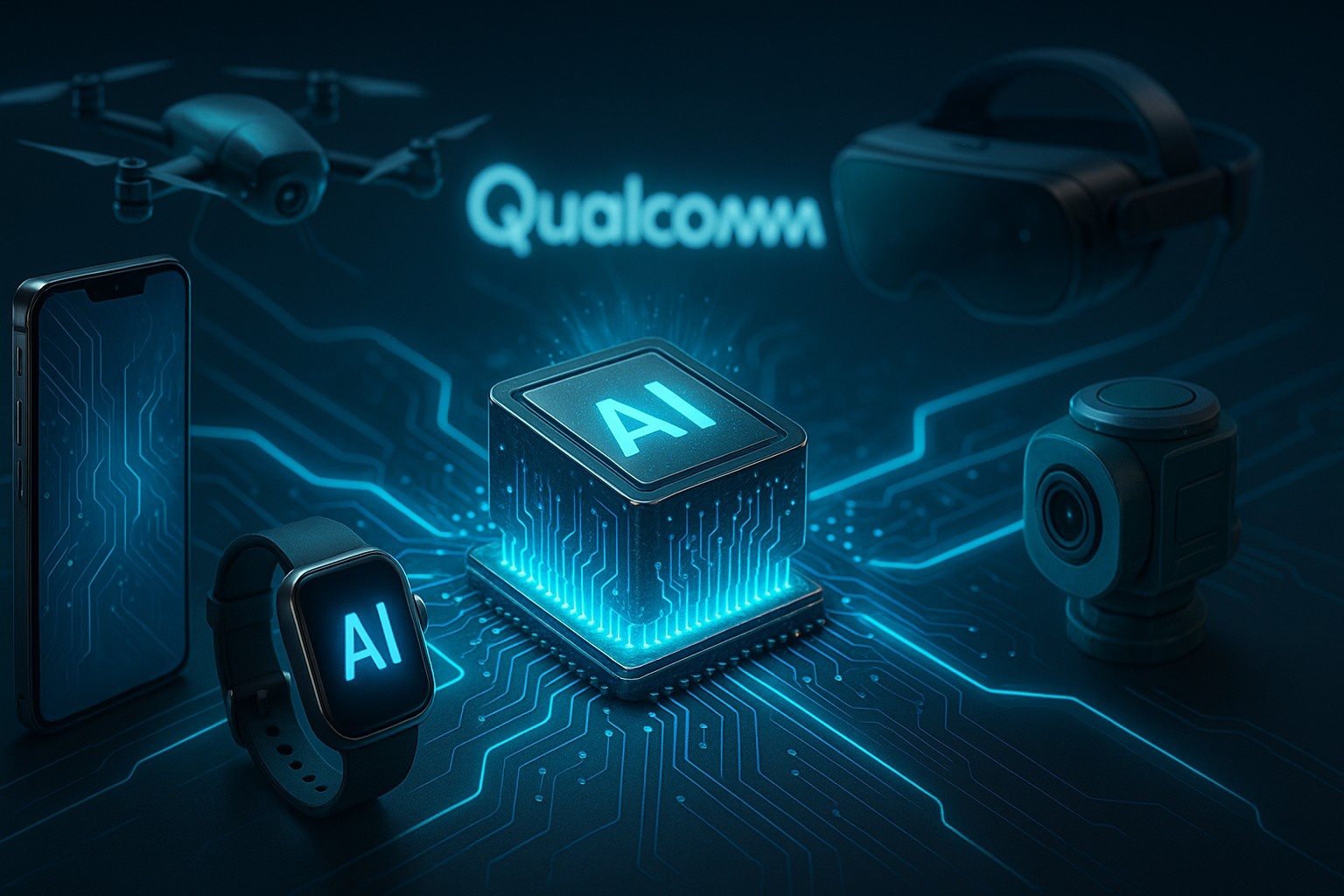Qualcomm Expands AI at the Edge with New Partnerships and 7-Series AI SoC Launch
On May 19, major tech media outlets reported that Qualcomm is deepening its investment in AI at the edge, announcing a series of new strategic partnerships alongside the release of a next-generation AI-powered System-on-Chip (SoC) under its popular Snapdragon 7 series.
These developments reinforce Qualcomm’s mission to enable on-device intelligence across smartphones, wearables, vehicles, and IoT devices, moving away from cloud dependence and toward distributed, privacy-conscious, low-latency AI computing.
The timing of the announcement—coinciding with major industry events like Microsoft Build and Computex 2025—underscores how AI at the edge has become a strategic battleground for chipmakers, platform vendors, and device manufacturers alike.
Qualcomm’s Edge AI Vision: Intelligence Without the Cloud
In recent years, Qualcomm has positioned itself as a leader in AI inference at the edge, with its SoCs powering billions of devices across mobile, automotive, XR, and industrial sectors.
Unlike traditional cloud-based AI approaches, edge AI allows devices to process data locally, enabling real-time responsiveness and improved privacy. This is crucial for:
- Smartphones and wearables requiring instant language translation, image recognition, or health monitoring
- Industrial IoT deployments in connectivity-limited environments
- Autonomous vehicles and drones needing split-second decision-making
- AR/VR headsets requiring low-latency contextual rendering
At the heart of this edge computing revolution is Qualcomm’s AI Engine, a multi-core architecture that combines CPU, GPU, DSP, and dedicated NPU (Neural Processing Unit) resources to execute AI tasks efficiently within power and thermal constraints.
New Snapdragon 7-Series AI SoC: Designed for Mass-Market Edge AI
The biggest hardware news from Qualcomm this week is the introduction of a new Snapdragon 7-Series SoC designed for AI-intensive tasks in mid-tier and premium mobile devices.
Key highlights of the new SoC include:
- 5th-gen Qualcomm AI Engine with enhanced INT4 and mixed-precision support
- Integrated Hexagon NPU delivering up to 15 TOPS of on-device AI performance
- Built-in support for Stable Diffusion, Whisper, LLaMA 3 mini models, and computer vision workloads
- Improved power efficiency for sustained AI inference on-device
- Compatibility with Android AOSP AI extensions and Qualcomm’s AI Stack SDK
This chip is expected to ship in upcoming Android smartphones, XR glasses, and consumer AI gadgets launching in Q3 and Q4 2025.
“We’re democratizing generative AI by bringing it to the edge—where users want faster, smarter, and more private experiences. Our new Snapdragon 7-Series chip enables true on-device inference at a global scale.” – Ziad Asghar, Qualcomm SVP of product management
Strategic Partnerships to Power the AI Edge Ecosystem
Alongside the SoC launch, Qualcomm announced new collaborations across sectors to accelerate AI deployment in real-world use cases.
1. Google
Qualcomm and Google are expanding their partnership to bring Gemini Nano—Google’s lightweight generative AI model—to more Android devices powered by Qualcomm chips. Gemini Nano will run natively on Snapdragon SoCs using Qualcomm’s AI Stack, allowing voice summarization, smart reply, and image generation to occur offline.
2. Microsoft
Qualcomm is working with Microsoft to optimize Windows Copilot Runtime and on-device inference for AI PCs using Snapdragon X Elite and upcoming AI-infused Snapdragon 7- and 8-series mobile chips. Windows developers will be able to run local language models on devices powered by Qualcomm, leveraging DirectML and the Qualcomm NPU runtime.
3. Meta
In the XR space, Qualcomm is collaborating with Meta to deploy on-device avatar rendering, object detection, and speech translation within Quest and Ray-Ban wearable ecosystems, reducing cloud latency and improving privacy.
4. Bosch and Siemens
For industrial IoT and smart building applications, Qualcomm is teaming with Bosch and Siemens to enable AI-enhanced predictive maintenance and autonomous inspection drones, powered by edge inference on Qualcomm’s IoT platform.
New AI Tools and SDKs for Developers
To make it easier for developers to target the edge, Qualcomm announced enhancements to its Qualcomm AI Stack, which now includes:
- Model Zoo for Edge AI: Pre-optimized open models like Whisper, LLaMA 3 Mini, ResNet, and YOLOv9
- AI Model Inspector: A visualization and profiling tool that helps developers understand layer-level performance
- One-click deployment pipelines for TensorFlow Lite, ONNX, PyTorch Mobile, and Qualcomm’s runtime
- Support for stable quantization techniques like INT4 and FP8 to shrink model size without sacrificing accuracy
These updates make it easier for OEMs, startups, and enterprise dev teams to train in the cloud and deploy at the edge, using Qualcomm silicon.
Practical Use Cases Showcased
Qualcomm demoed several real-world applications of its edge AI solutions during the announcement:
- Smartphone camera AI: Real-time background blur, multi-language scene text translation, and facial expression tracking—all running offline
- Wearable health tracking: Continuous heart rate and oxygen prediction using AI modeling without cloud sync
- Retail inventory monitoring: Vision AI models deployed in stores to track shelf stock and customer flow, running on low-power IoT cameras
- Automotive driver alertness system: Onboard AI detecting drowsiness, gaze shift, and passenger gestures without external compute
These applications highlight the versatility and scalability of Qualcomm’s AI hardware across industries.
Why This Matters: Qualcomm’s Competitive Position in AI
While most AI headlines focus on cloud-scale training and data center accelerators from NVIDIA, Intel, and AMD, Qualcomm has carved out a dominant role in edge inference, which represents a different but equally massive market.
According to IDC, the edge AI inference market is projected to exceed $40 billion annually by 2027, with over 60% of AI workloads expected to run locally rather than in the cloud.
Qualcomm’s advantages include:
- Billions of installed SoC devices globally
- Deep integration with Android, Windows, and IoT platforms
- Industry-leading power/performance efficiency
- A growing portfolio of AI developer tools and model optimization pipelines
With this week’s updates, Qualcomm has signaled that it intends to lead the next wave of AI deployment—not in the cloud, but in your pocket, on your wrist, and in every smart sensor around you.
Final Thoughts
Qualcomm’s May 19 announcements mark a significant acceleration in the company’s AI-at-the-edge strategy, anchored by a powerful new 7-series SoC and a broad ecosystem of collaborations across mobile, industrial, and cloud platforms.
By enabling on-device generative AI, vision inference, and edge intelligence at scale, Qualcomm is making it clear that AI isn’t just for supercomputers—it’s for the real world.
And with its silicon already powering billions of smartphones, wearables, and embedded devices, Qualcomm is uniquely positioned to deliver that vision now—not years from now.















